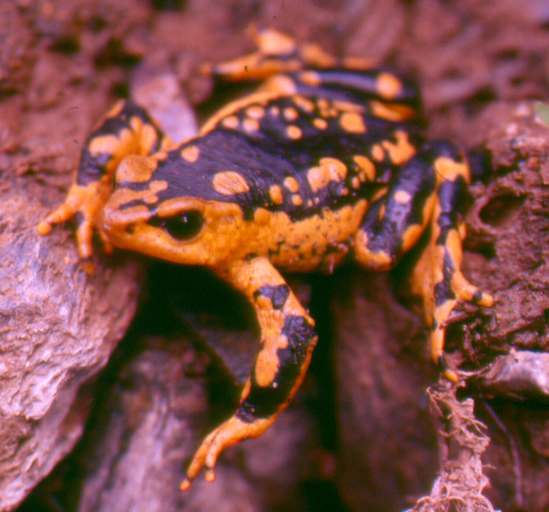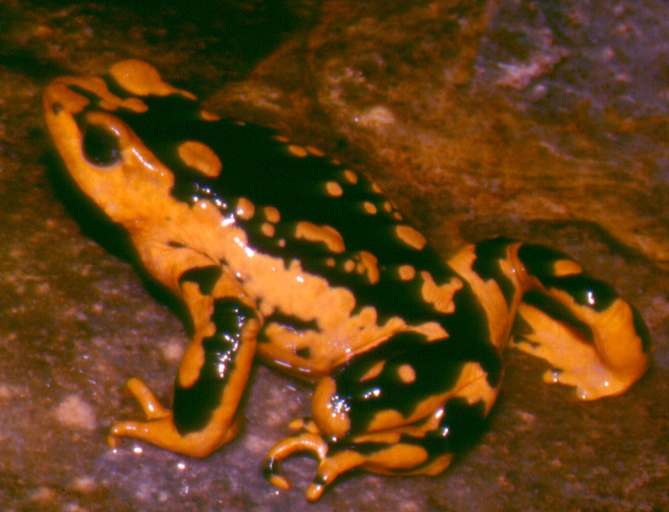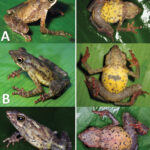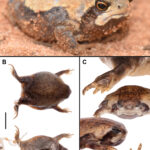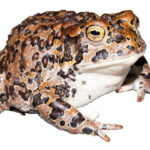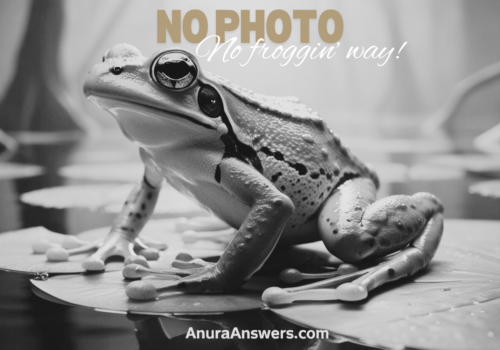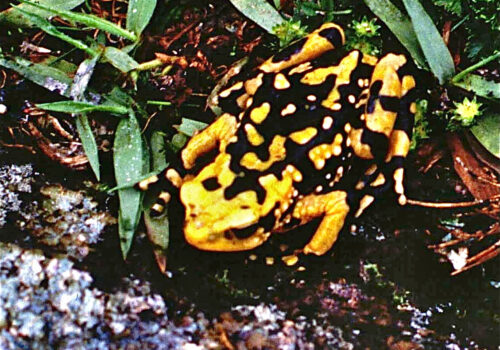- Atelopus patazensis: Discovering a Jewel of the Andes Under Threat
Atelopus patazensis: Discovering a Jewel of the Andes Under Threat#
Amidst the lush green slopes and mist-shrouded cloud forests of the Peruvian Andes, a small, spectacularly colored frog makes its home. Named Atelopus patazensis, this critically endangered amphibian belongs to a group sometimes referred to as “Harlequin Frogs,” celebrated for their striking appearance and fascinating behaviors. While most people might picture frogs as common denizens of ponds and wetlands, Atelopus patazensis thrives in habitats far more specialized and fragile, making it both mysteriously captivating and alarmingly vulnerable. Unique in coloration, characterized by intricate patterns and vibrant shades reminiscent of tribal jewelry, this remarkable species serves as both an ecological barometer and symbol of environmental fragility.
First described scientifically in 2008 by researchers establishing local biodiversity baselines, this charismatic amphibian rapidly became a conservation priority. Yet, its existence and future survival are increasingly jeopardized by looming environmental threats. Understanding this magnificent species offers us a narrative steeped in discovery, complexity, and urgency—highlighting the fragile beauty our world stands to lose if adequate conservation measures aren’t swiftly implemented.
Taxonomy and Classification#
Atelopus patazensis belongs squarely within the family Bufonidae—the large amphibian family commonly known as “true toads.” However, unlike typical toads many readers might envision—rough, brown, and monochromatic—species in the genus Atelopus, often called Harlequin Frogs, boast extraordinary diversity of colors and patterns, dazzling jewel-like creatures that defy traditional notions about toad aesthetics.
Specifically classified within genus Atelopus, A. patazensis shares characteristics with other closely related species, including vibrant coloration and slender body structure. The genus Atelopus itself comprises approximately a hundred described species, mostly native to Central and South America. Many have faced rapid population declines due to similar environmental threats, particularly climate change and diseases such as chytridiomycosis—a fungal infection devastating amphibian populations globally.
Natural Habitat#
Tucked away in the rugged terrain near the town of Pataz in northwestern Peru, Atelopus patazensis inhabits high-altitude cloud forests, flourishing between elevations of approximately 2,000 and 3,000 meters above sea level. These mist-drenched environments, characterized by dense, evergreen vegetation, mountainous terrain, and an abundance of pristine streams, provide the ideal microhabitat for this species.
The dense foliage diffuses sunlight, cloaking their delicate skins from harmful UV rays, while moisture-laden air creates a consistent humidity essential for amphibian survival. Freshwater streams crisscrossing their habitat serve not only as vital breeding grounds but also as critical territories rich with prey such as arthropods and aquatic insects. The specialized environment presents both opportunities and vulnerabilities—each habitat breaks down in nuanced interconnectivity. Remove one aspect, alter weather patterns slightly, or pollute streams even minimally, and this delicate subsistence is threatened significantly. Thus, protecting their habitat remains fundamentally interlinked with saving the species itself.
Physical Characteristics: Beauty Crafted by Nature#
Few observers encountering Atelopus patazensis fail to marvel at its stunning beauty. Measuring typically around 2 to 3 centimeters in adult length, they are relatively small amphibians. But what they lack in size, they more than compensate for in coloration and artistic appeal. Unlike common frogs or toads with uniform colors, the Harlequin Frogs erupt in brilliant hues—yellows, oranges, greens, and blacks form intricate artwork on their sleek bodies. Atelopus patazensis specifically displays bright yellowish colors interspersed with elaborate black patterning, rendering a contrasting, flamboyant camouflage paradoxically conspicuous yet simultaneously effective among shadowed leaves and tangled foliage.
This vibrant coloration serves dual evolutionary purposes. First, it functions as aposematic (“warning”) signaling, advertising their toxicity to potential predators, a trait shared by many brightly hued amphibians. Like other Harlequin Frogs, A. patazensis secretes chemical toxins through specialized skin glands, deterring predators who rapidly learn to associate their bright patterns with unpleasant taste or dangerous toxicity. Furthermore, their coloration blends surprisingly well with their dappled rainforest environment, allowing them to escape immediate notice.
Behavior and Life Cycle#
The daily existence of Atelopus patazensis unfolds quietly yet precisely within the shadows of the forest. These frogs are predominantly diurnal, actively foraging and navigating their environments during daylight hours, relying upon their excellent vision to detect minute prey items. Their eyes, disproportionately large in comparison to their body size, help them adeptly navigate a complex visual habitat—darting toward tiny insects, spiders, beetle larvae, and other arthropods among leaf litter and rocky streamsides.
Amorous Encounters#
Temperatures and humidity mark the rhythm of their activities, especially important as rainy season arrives, marking the onset of breeding season. Males adopt distinct territories upon rocks, logs, and stream banks, calling for mates with melodious, persistent calls reverberating through humid air. These mating calls, subtle yet distinctive, also signal territorial ownership, a dual-purpose communication effectively warding off competitor males while simultaneously attracting females.
Once a receptive female responds, mating usually ensues near or within water. Females deposit strings of tiny, gel-covered eggs in freshwater streams, securing the species’ next generation. Over weeks, these eggs metamorphose into tadpoles, inhabiting gently flowing, crystal-clear streams and consuming algae and micro-organisms clinging to submerged rocks. Over subsequent weeks or even months—depending on stream temperature, rainfall, and altitude—they develop limbs, absorb tails, and emerge as miniature adults, prepared for terrestrial existence inside the shaded, moist habitat of Andean cloud forest.
Ecological Role: Small Creature, Great Impact#
Despite their diminutive size, Atelopus patazensis plays an outsized role in ecological equilibrium. Like countless amphibians worldwide, they control insect populations, consuming significant numbers of arthropods which keeps ecological balance intact. Likewise, their tadpoles cleanse algae from rocks in stream ecosystems, preserving aquatic environments by managing algal growth.
Additionally, these frogs themselves are nourishment for various predators, including birds, snakes, and mammals, despite the threat of their mild toxins to these predators. Crucially, as sensitive bioindicators, they demonstrate rapidly the adverse impacts of climate change, habitat alteration, pollution, and disease on ecosystems, signaling ecological health or deterioration effectively.
Threats and Conservation Status#
Regrettably, Atelopus patazensis faces significant existential threats that have pushed this species to its current IUCN Red List designation as “Critically Endangered.” Chief among threats stands habitat loss, rampant deforestation resulting from logging activities, agricultural expansion, and copper and gold mining operations pervasive in the Andes. Mining introduces deadly pollutants and silts critical freshwater streams crucial for reproduction. Disturbances and fragmentation of habitats impair their ability to find suitable breeding grounds, decreasing reproductive success.
Perhaps unsurprisingly given its amphibian lineage, disease also represents a serious threat, particularly chytridiomycosis. Globally devastating amphibian populations, chytrid fungus, spread by human activities and amplified by climate-driven changes, weakens or kills these frogs, further reducing already strained populations.
A few dedicated conservation programs, involving both local communities and international experts, focus on habitat preservation, disease monitoring, ex situ captive breeding efforts, and environmental education programming. Unfortunately, these necessary efforts remain limited due to narrow resources, lack of clear governmental policies, and remoteness of their habitat, underscoring the critical urgency to expand conservation.
Cultural and Scientific Significance#
While perhaps unknown to much of the global audience, amphibians like Atelopus patazensis are culturally significant in their home regions. Locally, these unique frogs symbolize the health and richness of their ecosystems. Scientifically, Harlequin Frogs have inspired significant research insights into the impacts of climate change, habitat fragmentation, and disease spread among sensitive biodiversity indicators. The chemical compounds produced by their skin glands also attract biomedical interest, potentially harboring pharmacologically active substances—possibilities yet unexplored.
Conclusion: Our Shared Obligation to Protect a Fragile Heritage#
Atelopus patazensis invites us to gaze deeper into the hidden Appalachians of Peru, revealing a spectacular jewel poised perilously close to extinction. Their vibrant patterns, amazing adaptations, fragile behaviors, and critical roles within Andean ecosystems underline our interconnected responsibility to safeguard biodiversity’s richness.
Ultimately, the tale of the Patáz Harlequin Frog is our world’s tale—revealing wonders yet threatened by environmental damage. Embracing actions supporting habitat conservation, policy changes, ongoing scientific research, and community engagement offers hope. Join us in championing Atelopus patazensis, ensuring future generations, too, may marvel at nature’s delicate masterpiece secluded beneath Andean mists.
